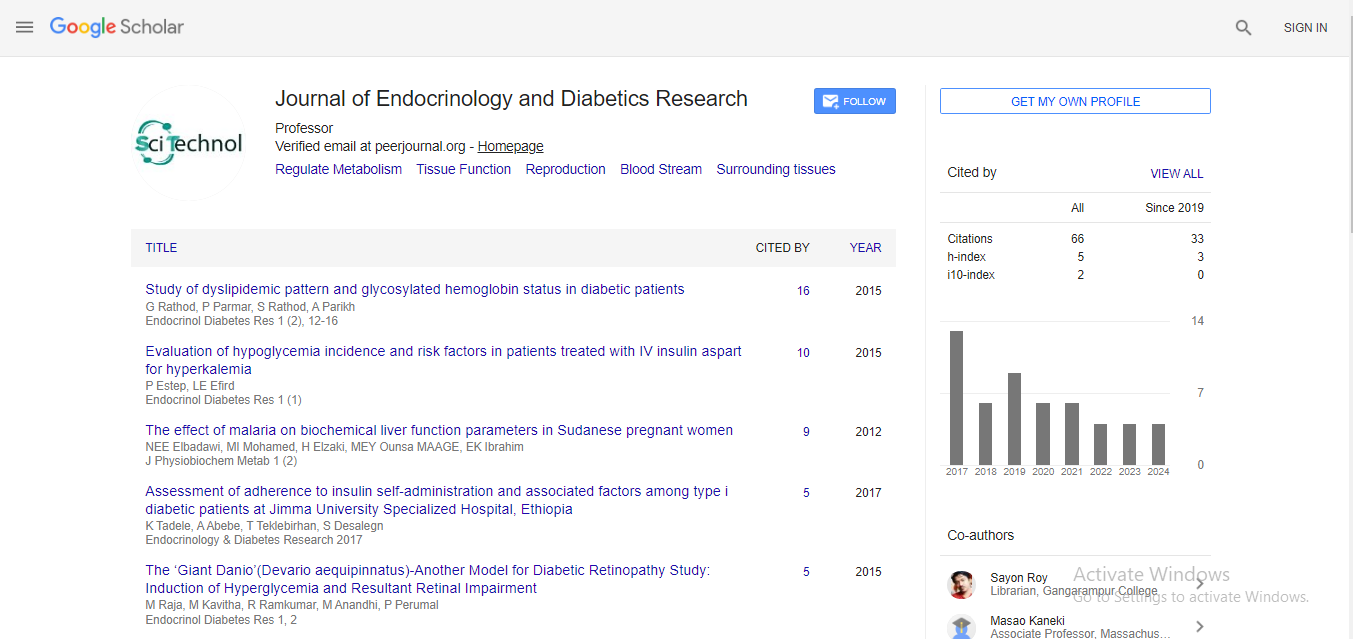Editorial, Endocrinol Diabetes Res Vol: 7 Issue: 10
Surgical Management of Pancreatic Neuroendocrine Neoplasms Women
Pancreatic Neuroendocrine Neoplasms (PNENs) are rare, accounting for less than 3% of all pancreatic tumors. PNENs exhibit a wide spectrum of clinical behavior that has made classification and staging difficult. While the majority of PNENs are associated with relatively good survival, there can be significant variability in outcomes based on their biological heterogeneity. PNENs share a unique genetic identity, functional behavior and clinical course. Compared with tumors of the exocrine pancreas, they are rare and show a different biological behavior and prognosis. Some PNENs are associated with symptoms of hormone secretion, with increased systemic levels of insulin, gastrin, glucagon or other hormones. More commonly, PNENs are non-functional, without hormone secretion. Surgical resection is the mainstay of therapy, particularly for localized disease that must be tailored to tumor and clinical characteristics. Surgery is indicated in patients with PNENs to alleviate systemic symptoms do to hormone over production, compressive symptoms due to local mass effect and to prevent malignant transformation or dissemination. Small, incidental PNENs are increasingly managed non-operatively. Surgery may also be indicated in some instances of metastatic disease, if all metastatic foci may be removed. This study outlines the surgical management and clinicopathological findings of pancreatic neuroendocrine tumors (PNETs). There are various surgical options, such as enucleation of the tumor, spleen-preserving distal pancreatectomy, distal pancreatectomy with splenectomy, pancreatoduodenectomy, and duodenum-preserving pancreas head resection. Lymph node dissection is performed for malignant cases. New guidelines and classifications have been proposed and are now being used in clinical practice. However, there are still no clear indications for organ-preserving pancreatic resection or lymph node dissection. Hepatectomy is the first choice for liver metastases of well-differentiated neuroendocrine carcinoma without extrahepatic metastases. On the other hand, cisplatin-based combination therapy is performed as first-line chemotherapy for metastatic poorly differentiated neuroendocrine carcinoma. Other treatment options are radiofrequency ablation, transarterial chemoembolization/embolization, and liver transplantation. Systematic chemotherapy and biotherapy, such as that with somatostatin analogue and interferon-α, are used for recurrence after surgery. The precise surgical techniques for enucleation of the tumor and spleen-preserving distal pancreatectomy are described.
Abstract
Pancreatic Neuroendocrine Neoplasms (PNENs) are rare, accounting for less than 3% of all pancreatic tumors. PNENs exhibit a wide spectrum of clinical behavior that has made classification and staging difficult. While the majority of PNENs are associated with relatively good survival, there can be significant variability in outcomes based on their biological heterogeneity. PNENs share a unique genetic identity, functional behavior and clinical course. Compared with tumors of the exocrine pancreas, they are rare and show a different biological behavior and prognosis. Some PNENs are associated with symptoms of hormone secretion, with increased systemic levels of insulin, gastrin, glucagon or other hormones. More commonly, PNENs are non-functional, without hormone secretion. Surgical resection is the mainstay of therapy, particularly for localized disease that must be tailored to tumor and clinical characteristics. Surgery is indicated in patients with PNENs to alleviate systemic symptoms do to hormone over production, compressive symptoms due to local mass effect and to prevent malignant transformation or dissemination. Small, incidental PNENs are increasingly managed non-operatively. Surgery may also be indicated in some instances of metastatic disease, if all metastatic foci may be removed. This study outlines the surgical management and clinicopathological findings of pancreatic neuroendocrine tumors (PNETs). There are various surgical options, such as enucleation of the tumor, spleen-preserving distal pancreatectomy, distal pancreatectomy with splenectomy, pancreatoduodenectomy, and duodenum-preserving pancreas head resection. Lymph node dissection is performed for malignant cases. New guidelines and classifications have been proposed and are now being used in clinical practice. However, there are still no clear indications for organ-preserving pancreatic resection or lymph node dissection. Hepatectomy is the first choice for liver metastases of well-differentiated neuroendocrine carcinoma without extrahepatic metastases. On the other hand, cisplatin-based combination therapy is performed as first-line chemotherapy for metastatic poorly differentiated neuroendocrine carcinoma. Other treatment options are radiofrequency ablation, transarterial chemoembolization/embolization, and liver transplantation. Systematic chemotherapy and biotherapy, such as that with somatostatin analogue and interferon-α, are used for recurrence after surgery. The precise surgical techniques for enucleation of the tumor and spleen-preserving distal pancreatectomy are described.
 Spanish
Spanish  Chinese
Chinese  Russian
Russian  German
German  French
French  Japanese
Japanese  Portuguese
Portuguese  Hindi
Hindi 


